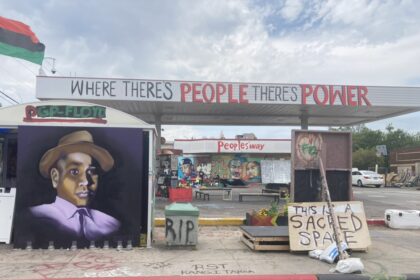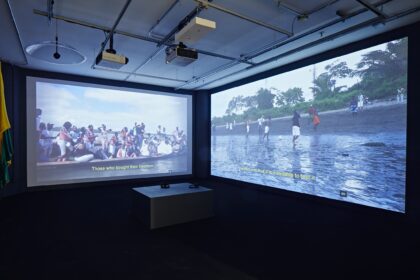Wages Against Artwork: Decommodified Labor and the Claims of Socially Engaged Art, by Leigh Claire La Berge (Durham: Duke University Press, 2019)
Noni Brynjolson
In our society, art is often seen as an escape from work—associated more with sensuality and play than with the obligation associated with doing a job for pay. Yet in the past few decades this belief has come into question, as the potential for art to escape commodification and remain autonomous from capitalism seems more and more like a utopian dream. What potential still exists for aesthetic experiences that stand outside of capitalism? And how do these dichotomies function under the changed status of labor represented by the economic frameworks of neoliberalism and real subsumption (real subsumption refers to the manner in which social relations and labor practices have been transformed under capitalism). These questions are examined by Leigh Claire La Berge in her book Wages Against Artwork: Decommodified Labor and the Claims of Socially Engaged Art. La Berge is an Assistant Professor of English at the Borough of Manhattan Community College, City University of New York. Her grounding in literature is apparent through her thoughtful readings of a number of socially engaged artworks that represent or enact forms of decommodified labor—labor that could be remunerated with a wage, but is currently not, for a number of different reasons. Reading La Berge’s book during this current moment of pandemic, economic crisis, and justice for black lives protests brought up many questions for me: about the possibilities and limitations of socially engaged art, about its redistributive aspirations, and about the frameworks we use to envision radical social change.
The title refers to Silvia Federici’s 1975 pamphlet Wages Against Housework, which argued that housework had come to be seen as an inherently feminine activity: “a natural attribute of our female physique and personality.”[1] Federici argued that wages were needed, yet at the same time, wages were not enough. La Berge adopts this argument to make a more expansive claim regarding contemporary economic relations. Grounding her text in Marxist theory, she emphasizes the continued centrality of labor, contrasting this with neoliberal models of entrepreneurialism in which labor disappears and work is instead reframed as an investment in human capital. She examines how and why many forms of labor have become decommodified, outlining useful and imaginative parallels between artists, who work on their art with no guarantee of ever receiving compensation; students, who are encouraged to view tuition payments as investments in their future; animals, who cannot be paid, but who play a crucial economic role in our society; and children, who are no longer paid for their labor, and have become “priceless” as a result.
Wages Against Artwork makes an important contribution to the literature on socially engaged art, since as La Berge points out, “those writing about socially engaged art have yet to produce an economic concept to buttress their criticism.”[2] She argues that the concept of decommodified labor performs this role since it makes the redistributive aims of socially engaged art more visible, and she unpacks this claim through a number of examples that are considered in great depth and detail. In discussing the decommodified labor of art students, she traces histories of radical organizing by students, including the 1970s group Wages for Students, which went a step beyond calls for free tuition by arguing that students should be compensated since they were involved in the work of “reproducing capital by reproducing a new generation of skilled workers.”[3] La Berge discusses the work of Cassie Thornton, whose MFA project consisted of working on the debt that she accumulated by paying tuition to California College of the Arts (CCA). Thornton and other contemporary socially engaged artists go further than student activists of the 1970s, says La Berge, because they have ceased to demand wages. Instead, they “refuse their student loans on both political and artistic grounds, and in doing so, they show the extractive exchange they have been offered in place of wages for their work as art students—what they call their ‘debt.’”[4] Thornton’s work centers around what she refers to as debt visualizations, and has included hiring a performance artist to “stage scenes of financial distress”[5] at CCA arts events, and applying for a made up artist residency position at the London School of Economics. La Berge also discusses Thomas Gokey’s involvement in Rolling Jubilee, an initiative that raised $700,000 in order to purchase $32 million worth of medical and student debt. Within both of these projects, she points out that “art school becomes in part an experience of being trained as a decommodified laborer, and once so trained, one then uses that training in the service of critique, what used to be called ‘institutional critique.’”[6]
La Berge points out a common criticism of Rolling Jubilee, which is that it legitimized the structural apparatus of debt, rather than providing a substantial critique or envisioning alternative forms of economic relations. This criticism speaks to a broader tension that runs through the examples discussed throughout the book: radical, critical visions, versus more possible, practical reforms. This is explored in her next chapter, as well, in which she discusses a number of projects that attempt to rethink forms of exchange outside of capitalism. For example, Caroline Woolard’s OurGoods piece, an online platform for bartering, and Trade School, a similar network through which students bartered for classes with instructors. While these initiatives were intended to function outside the wage system, their popularity and success brought them to the attention of investors who saw the platforms as ripe for commodification, which La Berge compares with the monetization of sharing economy services.
While most of her examples focus on the U.S., La Berge does examine the relationship between the global north and south through several projects, including Duke Riley’s work with pigeons, which he trained to fly between the U.S. and Cuba, and Renzo Martens’s work in Congo. Martens produces what La Berge refers to as “socially engaged business-as-art” projects that advocate for wages for Congolese plantation workers.[7] She discusses his 2008 film Enjoy Poverty, which was viewed by some critics as inappropriately satirical, and as perpetuating racist and imperial tropes. But her main interest is in Martens’s later work, which has involved establishing art institutions that sell work made by plantation workers. This includes self-portraits that are made in Congo out of river clay, recreated in Amsterdam using Congolese cocoa, and then sold for €39.95. The project is a good example of the redistributive nature of socially engaged art that La Berge foregrounds throughout the book—but also brings up important questions for her, such as Martens’s role in the project. She wonders: “why is the poverty of Congolese plantation workers his issue to solve?”[8]
One of the most fascinating chapters in the book focuses on children and their historical relation to the wage. La Berge looks back to the prohibition of child labor in 1938 in the U.S., and argues that as they became economically useless, they came to represent an escape from commodification through an association with playfulness and innocence. This idea has been explored through numerous socially engaged art projects featuring children—especially through the forms of art education and community programming. La Berge seems to share certain criticisms of these projects with Claire Bishop, who has dismissively referred to them as “a predictable slew of children’s workshops.”[9] La Berge focuses instead on a number of projects that seemed to be more in line with relational aesthetics than with socially engaged art—at least in the sense of redistribution that she associates with the latter. For example, Mammalian Diving Reflex’s Haircuts By Children, and Tino Sehgal’s work with children as interpreters. I appreciated her explorations of how decommodified labor was represented within these works, but I also wondered how she might have addressed more community-based practices that often exist on the margins of the contemporary art world, and that are involved in practical forms of redistribution through the private and public funding they receive.
This question also made me wonder how La Berge might connect her examples of socially engaged art with activist movements taking place outside of the art world. For example, the Fight for $15 campaign, which is not mentioned, and Universal Basic Income, which is mentioned very briefly. It would have been interesting to read about how these specific movements intersect with her views on decommodified labor, especially since they have now entered mainstream discourse.
Throughout the book, La Berge emphasizes the abstract form of the wage, instead of engaging with concrete examples of activism. She addresses this approach in her Epilogue, stating that she has considered the wage as an abstraction instead of examining it in relation to the specificities of race, gender and nationality.[10] This allows her to foreground the centrality of labor as a Marxist concept, and to make a strong argument for the importance of decommodified labor as a grounding framework within socially engaged art. However, I felt like some of her analyses of specific artworks would have benefitted from a more localized, intersectional reading, perhaps going beyond Marxist theory and incorporating insights from critical race theory. Black Marxism is mentioned briefly in her introduction, but she doesn’t engage with scholars who have examined structural racism in the United States, and whose work might have brought insight into looking at how the historical inequities of wage labor relate to the trauma of slavery (looking at the 1970s group Black Women for Wages for Housework might have been especially insightful). It may have also proven worthwhile to discuss examples of organizations that artists have worked with to address not just the decommodification, but the broader devaluation of labor by people of color—a disproportionate number of whom are now on the front lines of the Covid-19 crisis as low-wage workers.
The most compelling and thought-provoking books always make me want to read more, and this was the case with Wages Against Artwork—I am returning to familiar texts now to see how they might be put into conversation with La Berge’s analyses of de-commodified labor in socially engaged art. It’s a useful book for thinking about how economic relations might be transformed in the next few years given the multiple crises we are facing. One thing seems certain at least: with all of the cuts to arts funding, public education, and social programs in general, the situation for artists will become even more dire. In this context, questions centering around work and wages are incredibly important to ask right now—especially since we may be entering a moment of instability, when discussions of rebuilding take on added significance and potential.
Notes:
[1] Silvia Federici, Wages Against Housework, Bristol: Power of Women Collective and the Falling Wall Press, 1975. https://monoskop.org/images/2/23/Federici_Silvia_Wages_Against_Housework_1975.pdf, accessed June 7, 2020.
[2] La Berge, p. 36.
[3] La Berge, p. 39.
[4] La Berge, p. 44.
[5] La Berge, p. 74.
[6] La Berge, p. 101.
[7] La Berge, p. 106.
[8] La Berge, p. 8.
[9] La Berge, p. 159.
[10] La Berge, p. 202.











